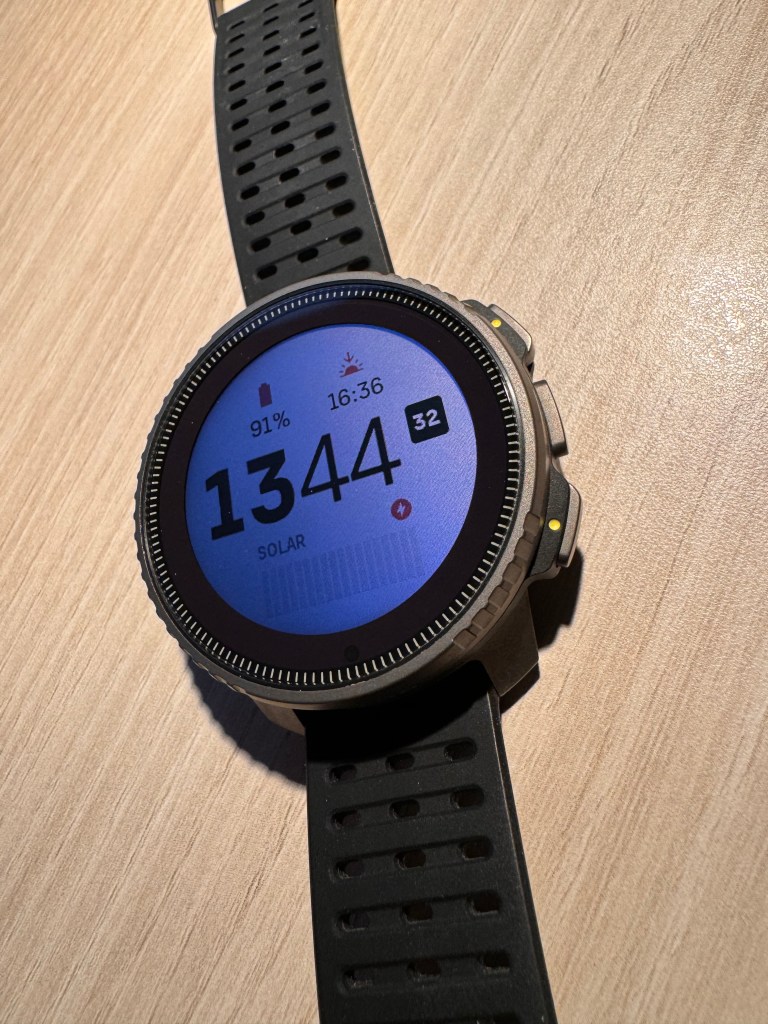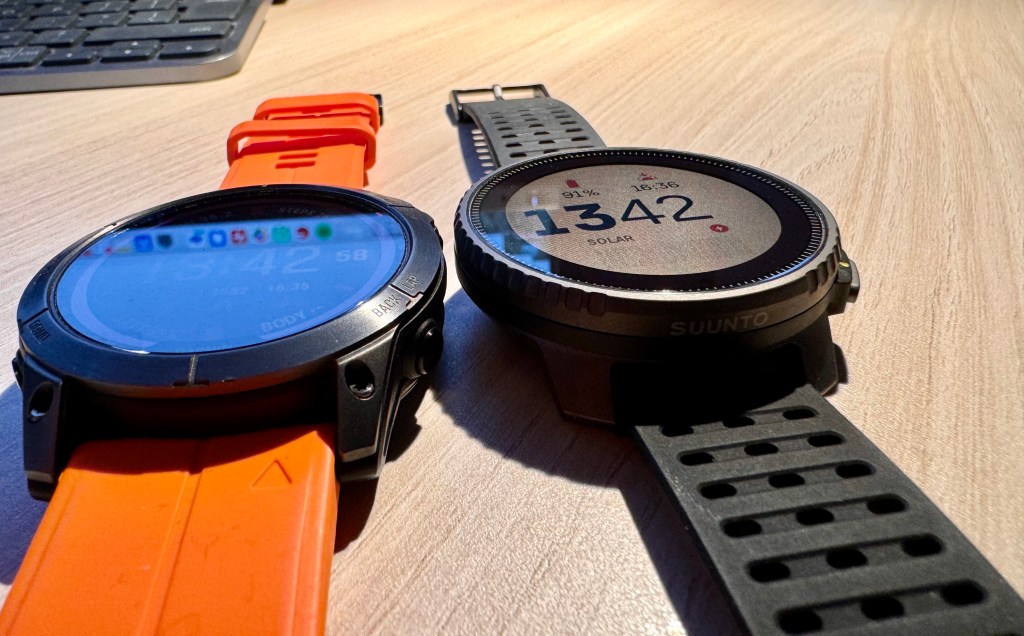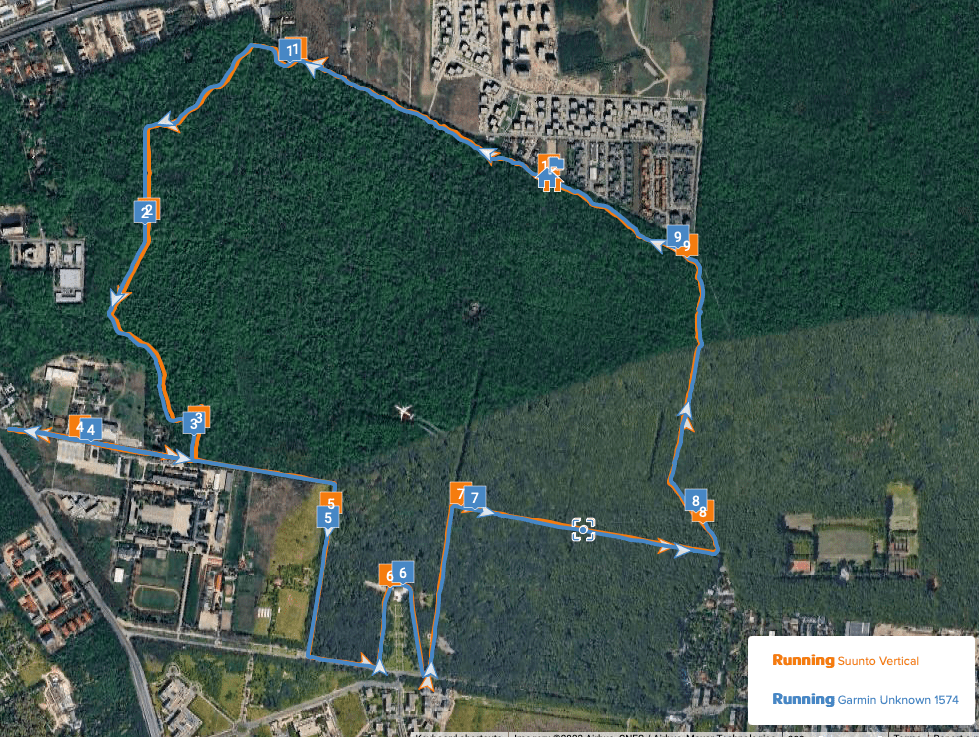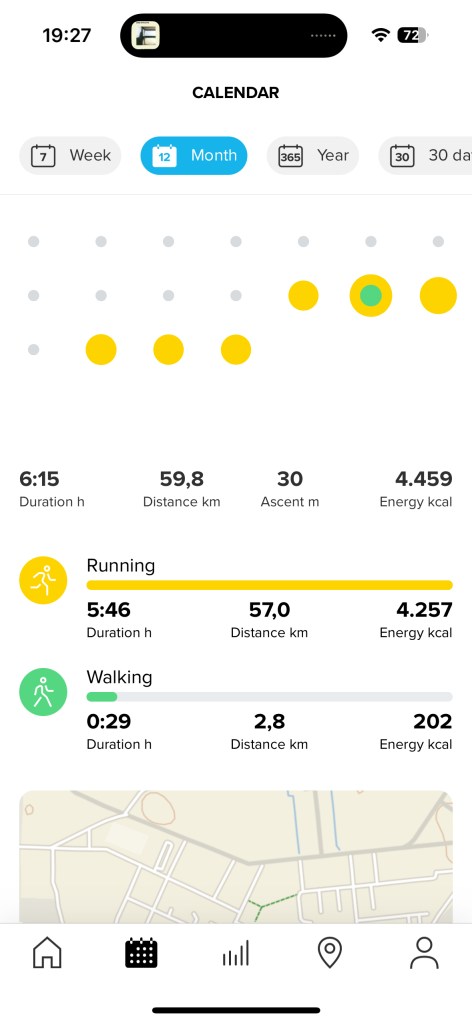I was always an admirer of Suunto as a brand, liked their products but only had limited interaction with them – I mean, I have a Suunto Spartan Trainer HR which belonged to my kid and I run with it 2-3 times, but always wanted to test their best devices.
This year, Suunto make their come back with two devices – Suunto Vertical and Suunto Race, one MIP and one Amoled screen with similar features (there are some differences since Race has some third party algorithms licensed for their sleep analysis for example) – basically they are the same in terms of features, especially after the latest November firmware update.
The look of the Suunto Vertical, the promise of a long battery life and great features made me very interested in trying and buying one, so finally I bite the bullet and purchased a Suunto Vertical Solar Black – it has a sapphire glass and titanium frame – a very nice looking and decently light sport watch. The solar titanium version is positioned usually at 800EUR, but I managed to find it for 600EUR and even though I had a strong preference for the Solar Canyon version I settled for the Black one, with the idea that I’ll purchase eventually a band later. As a side note, I found that the orange band is only available from Suunto (and their partners) for 50EUR but you can’t find this color on Amazon looking for third party bands.

Firstly, after registering the device, I updated the firmware and downloaded some maps on my device. The first operation (update the firmware) was quick, the second less so because for the map of Romania (1.7GB) I had to wait close to 2 hours to finish to download on the device, while having the phone close by and a (more than) decent internet connection (1 Gbps). Anyhow, this is manageable since I don’t expect to use the maps download everyday and for such large datasets.
Design and Aesthetics
The device is nice and light, easy to wear and comfortable. Since I’m used with big watches (Fenix 7X and Apple Watch Ultra were on my wrist during the last months) I found the Suunto Vertical easy to wear 24/7, it didn’t bother me during my runs or during night. On paper, Suunto Vertical (13.6mm) it looks to be thinner than the Fenix 7X (14.9mm), but in real life that’s harder to detect this difference .. maybe it’s just because of the lugs.

The band is comfortable and has a very nice hooking mechanism, so you don’t need to worry about the loose end of the band. In my opinion, the band (22mm) could be wider considering the size of the watch (maybe because I got used to the 26mm band of the Fenix 7X), but at the same time is comfortable and stretchy.
The screen is a nice and high contrast 1.4” MIP display, with a resolution of 280×280 px and a good backlight. It uses an ambient light sensor to adjust the backlight intensity, I never had any issues reading it in any setup – indoors or outdoor. Especially outdoors, if it’s sunny you can see the advantages of the MIP screen and big fonts. The solar ring is wider than with Fenix 7X and based on others feedback (and Suunto’s claims) it could actually contribute to extend significantly the battery life (more so than the Fenix 7X). I couldn’t actually test the battery life extension by solar power because it’s winter and the sun is not as much available, but I noticed that the sensor is very responsive and captures light fast so I’m sure that Suunto Vertical is a great tool for the outdoor adventurers during long summer days.
GNSS and HR accuracy
As a device marketed as an outdoor adventure sport watch, the Suunto Vertical excels at GNSS accuracy, being very fast in acquiring signal and maintain it in various conditions. To me, it rivals the recent devices from Garmin (7 and 7 Pro lines) as it has dual-frequency (L1+L5) capabilities and it’s able to connect up to 32 satellites. Most of my runs, the track was just fine, distance and pace were also very good. Even though Suunto Vertical is able to connect to a Stryd footpod, the page stability and GNSS accuracy doesn’t make the Stryd a necessity. Even the running power is good and reliable outdoors, Suunto offers native running power from the device without the need for external footpod. Indoors, Stryd is an obvious better partner.

Even if the Suunto has some limitation in the number of pages (4) you can add to an activity profile, I found the information easy to see and actually better to understand when glancing at the watch during run than with the Fenix 7X. So, if it would be to pick one for using during a run, Suunto would win, because of the fonts, the lap summary and the display of the map which is somehow easier to use and very responsive. I don’t feel a need for more screens, usually I stay on one and eventually switch to map from time to time if needed .. so for me, it works fine. For HR, the sensor doesn’t look to be as good as the Garmin Elevate V4 or V5, but does a decent job for steady activities. I don’t rely on the oHR sensor anyway (except maybe with the Apple Watch) so I usually wear a Polar Verity Sense armband or H10 strap to be sure that I’m capturing accurate heart rate values with heavier watches like Fenix or Vertical.

My GNSS results were just fine and for HR I only used the optical HR sensor for 2 runs, for the rest I use an arm band or a chest strap. In one situation, I’ve seen the Vertical being completely “mad” with both GPS and HR, but I would consider this to be an exception rather than the norm.

And since I mention sensors, surprisingly Vertical only accepts one sensor per type and doesn’t name it … for example, if I decide that I want to wear the Polar H10 strap and last time I used the Polar Verity Sense I need to pair it explicitly before the workout, just by remembering myself that last time I used a different sensor. This is a rather stupid limitation and it’s the first time I encounter such a situation. For those with multiple HR sensors or more than one bike with their own sensors, you’ll add some manual work before starting the workout, which may become annoying pretty fast.
The best quality Suunto Vertical has is related to battery life – both during the outdoor adventures and just using the watch 24/7. For me, the battery is great – far exceeding the 7X which is to 2 years old. It could work, extrapolating the consumption I’ve seen so far, up to 60 hours with the highest setting on GNSS and also for weeks in full use (24/7 readings and connected to the phone).
As a daily wear, the device is ok but not spectacular. I mean .. the number of steps is overestimated compared with the other devices, the sleep is underestimated (it usually is registered an hour after I’m already asleep). Suunto could do a better job with the sensors. For sleep, I’m not asking for stages analysis, but it’s the first time I see such differences of times – the Fitbit, Garmin, Polar and Apple Watch did a better job here. Based on the comments in Suunto’s forum, the issue with the sleep accuracy is new, after the recent firmware and presumably will be fixed with a subsequent update – but for now, it’s annoying. I don’t care about steps, but I’d love to see at least the sleep duration being captured right (as it’s also used in some nice stats in the app)
The phone notifications are not spectacular, better than Polar Vantage V2 in a way, but still way below Garmin (I’m not considering Apple Watch for this competition).
The customisation capability is limited, the watch faces not that many, but I find the solution to be reasonable considering the target of this device – this is not a smart watch, this is an outdoor training tool.
Platform – Suunto App
After Movescount platform sunset, Suunto focused on enhancing the mobile Suunto App and they did a great job, because the app is intuitive and easy to use. It has a lot of charts and data displayed in a sensible way, showing the trends you need to understand – either the daily stats (steps, energy, sleep, HR, HRV) or training stats (CTL, ATL, Form, etc). Also, the maps to create the routes (or POIs) to be sent to the watch are easy to use, easier than on Garmin Connect.



On the other hand, simplicity and intuitiveness has some limits as you can’t dive deep into the details – for example, you can’t see status of your sleep beyond the week, the same with the HR values. If you need this kind of details (like searching some specific workout based on distance or location) you need to pair your Suunto App with an additional platform to complement the data analysis. I mean, you can do a decent job with what the app offers, but if you want to see trends over longer periods of time or search deeper, you need additional platforms.
What I liked
- It looks very nice .. that’s obviously personal, but it looks nice
- Battery life is sensational, both during GNSS activities and 24/7
- Visibility of the training stats (default screens) during running for example is great .. much better than the Fenix 7X with a larger screen – the contrast is higher, the fonts better ..
- Maps are nice and easy to use, compass is very responsive – you can use maps even if you don’t have the labels on the screen
- The iOS app is nice and intuitive, has brilliant display of stats and data but if you want to go deeper than that, you’re out of luck
What I didn’t like
- Voice cues are nice initially but they may become annoying since you can’t specify you’d like to know only lap stats and eventually when you’re out of the prescribed activity interval
- Steps counting [if that’s important] is not as performant as others – they over estimate the number of steps consistently, depending on your hand movements I presume
- Sleep measurement is not as good as the other devices I tried (Apple Watch Ultra, Garmin Fenix, Polar Vantage V2) – they may not agree on the sleep stages, but rarely I’ve seen differences of more the 2-5 mins between them regarding asleep time and awake time; Suunto (based on the forums, only after the latest firmware update) manages to miss the start by hours easily, thus affecting some of the recovery info
- Light management is not as polished .. like DND maybe should be turned off automatically when you’re awake (that should overwrite the default schedule you setup)
- Maps are slow to download .. luckily I don’t have to do it so often .. but it took hours effectively to download almost 1.8GB of maps and the internet connection was capable of 1Gbps
- Phone notifications are working imperfect.. I haven’t seen a call alert on my watch so far, did receive the text messages with some delay. I’m not expecting Apple Watch here .. but I like Garmin better, Suunto seems to be similar to Polar, maybe a bit better because it allows theoretically calls and text messages but not all the rest of the notifications (which is not possible on Polar)
Summary
The Suunto Vertical Solar is a great outdoor tool, with an exceptional battery life and a great GNSS capability. With the proper updates, it could be a great competitor for Fenix in the eyes of people who value reliability and robustness over features. It won’t match Garmin in terms of features (music, payments), but those that are implemented for the right audience will work fine and for long. Maybe the price is a bit too high .. kind of creating a even smaller niche of enthusiasts to select the watch, but there is always the option of Suunto Race for the same features in a Amoled package at an atractive price point. Even though I value battery life, for the current price there are still some gaps to be closed (sleep accuracy, sensors) before saying that the Vertical will stay on my hand from now on – but the potential is there and I hope Suunto will build on that.
With that, enjoy your runs!